[Mac Recovery] Mac Catalina/Mojave Update Deleted Everything
Have you encountered the frequently happening issue that the Mac update deletes everything? Don't worry. This page has solved the problem with four workable solutions:
| Workable Solutions | Step-by-step Troubleshooting |
|---|---|
| Fix 1. Recover Lost Data with Software | Download Qiling file recovery software > select file lost location > scan...Full steps |
| Fix 2. Restore from Time Machine Backup | Step 1. Open up Launchpad on Mac, click "Others". Step 2. Find and enter Time Machine...Full steps |
| Fix 3. Recover from iCloud Backup | Open Cloud.com > Go to Settings > Select "Restore Files" under Advanced...Full steps |
| Fix 4. Recover from APFS Snapshot | Restart Mac and hold Command + R > Recovery Mode > Select "Restore from Time Machine Backup"...Full steps |
New Features of macOS Catalina 10.15
After Mojave, the latest version of macOS - Catalina is now available to download. Most Mac users have their macOS from Mojave 10.14 to Catalina 10.15. It's free and worthwhile to upgrade your Mac and enjoy the new features of Catalina.
- 1. Remove iTunes: Beginning with Catalina, iTunes is expected to be replaced by Apple Music, Apple TV, and Apple Podcasts.
- 2. Support Second Screen: Catalina also offers second screen support for utilizing iPads as a companion second screen from Mac computers.
- 3. Sidecar - use your iPad as drawing tablet: After connecting the iPad through Sidecar, users can use Apple pencil to draw and annotate things to iPad.
- 4. Screen Time: Screen Time allows users to set App Limits across all of your Apple devices, not just your Mac.
- 5. Updated Photos App: The Photos app curates and features your best photos, removing poor-quality photos and duplicate shots.
However, during the upgrading process, you be faced with data loss problems. Back up your Mac data before you take action. If you have lost data, see the following part.
Mac Update Deleted Everything
"I updated my Mac to Catalina 10.15 and lost everything. My entire hard drive has been wiped. Nothing on my desktop, documents, mail, folders, etc. The applications are there, but that's it. My mail is gone, my profile appears as though it has been newly created. Is there any way I can restore the lost files or am I screwed..."
To most Mac users who lost data during macOS update, they all have three questions on their minds: 1. Why does macOS update delete everything? 2. Is lost data recoverable? 3. How to get the new features and get back lost data?
As a matter of fact, very few Mac users know the causes of data loss after macOS updates. To start Mac data recovery due to macOS update, check the causes first and learn why your data can be restored.
Why did macOS update delete everything?
Generally, a subsequent major release of macOS won't erase or touch user data. Pre-installed apps and configurations will also be kept in the upgrade. However, you should be cautious and be responsible for the sanity of your data. Upgrades don't negate the possibility of going wrong, and in the unlikely case, you may lose access to data due to the following causes:
- Hard drive failure or file system error
- Unfinished macOS update, macOS update failure, or OS crash
- Not enough space on the hard drive for OS update
Is lost data recoverable?
In fact, lost files can be recovered. When a file is accidentally or intentionally deleted from Mac, only the pointer to it is deleted, not the actual file. The data is not physically deleted from the system until it is overwritten with new data.
If you find your files missing after mac update, stop using the device to avoid writing any new data on the hard drive. Then follow the solutions below to recover lost data after the macOS 10.15 update.
Solutions to Recover Files After macOS Catalina/Mojave Update
When Mac update deletes everything on your computer, try the following solutions to recover all missing files.
If you have backups, you can retrieve data from the backup. If you have no backup, you must use professional Mac data recovery software to get back data as soon as possible.
Solution 1. Recover Lost Data with Qiling Data Recovery Software for Mac
Qiling Mac data recovery software - Data Recovery Wizard for Mac can recover lost data after macOS 10.15 update. Besides, if you are faced with the following problem, you can also use this data recovery software to regain the deleted or missing data.
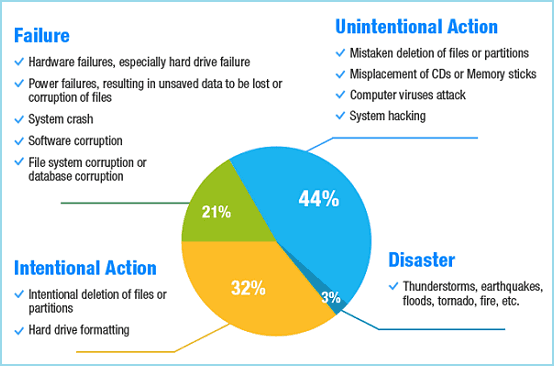
Let's see how to recover lost data and missing files after Mac update:
Step 1. Launch Deep Data Recovery. Select file types and click "Next" to start.

Step 2. Where was data lost after operating system update? Choose the location and click Scan.

Step 3. Deep Data Recovery for Mac will immediately scan your selected disk volume and display the scanning results on the left pane.

Step 4. After the scan, select the target files that were unknowingly lost during or after the update and click Recover button to get them all back.
Solution 2. Restore macOS Catalina/Mojave Data from Time Machine Backup
This method works well only if you have Time Machine backups. You can easily get deleted, lost, or missing data back by following these steps:
Step 1. Open up Launchpad on Mac, click "Others".
Step 2. Find the Time Machine icon and click it to enter Time Machine.

Step 3. Use the up and down arrow to scroll the timeline to browse the backups.
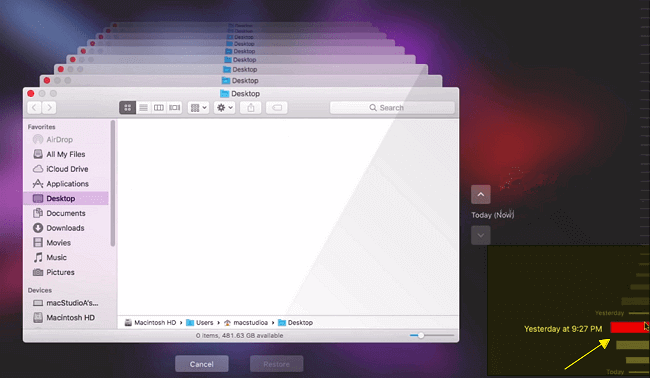
Step 4. After finding the files that you want to recover and click "Restore" to recover those lost data from Time Machine on macOS Catalina/Mojave.

Solution 3. Recover Missing/Lost Files from iCloud Backup
Some Mac users have the habit of backing up their data and files to iCloud. To these Mac users, it seems to be good news when their files are missing or lost after the macOS update.
Here are the steps to bring lost Mac files from iCloud backup:
Step 1. Go to iCloud.com in your Mac browser and log in with your Apple ID.

Step 2. Go to Setting and scroll down to the bottom of the page.
Step 3. At the bottom left, click on "Restore Files" under Advanced.
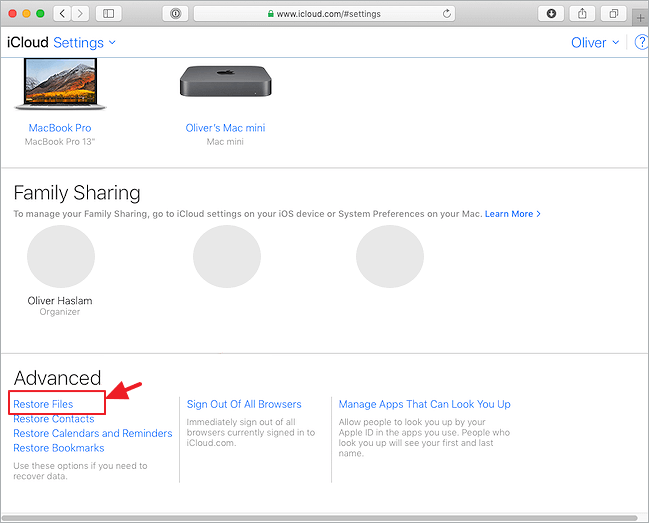
Tips: To restore contacts, bookmarks, calendars, and reminders from iCloud, click the corresponding option under Advanced.
Step 4. Check the files you want to restore or click "Select All" if you really need to restore everything. Click the Restore button to recover them.

Solution 4. Restore Files from APFS Snapshot using macOS Recovery
Being similar to System Restore in Windows OS, macOS like High Sierra, Mojave, and Catalina also enable users to use macOS Recovery feature to restore files from APFS snapshot. It only works on macOS Catalina, Mojave, and High Sierra.
A snapshot will automatically be taken once the install or update of your macOS starts. You need to agree to the license terms so to enable snapshots to start. A snapshot contains the current state of the target disk, including files, macOS version, etc. Also note that snapshots are a feature of APFS, and if the target drive is not formatted with APFS no snapshot will be saved.
If you don't want to revert macOS Catalina or Mojave to the previous state, go back to solution 1 and let reliable Mac file recovery software help.
If your Mac hard drive is with APFS, you can accept the result of restoring files from APFS snapshot, bringing macOS to the previous state, follow the steps below:
Step 1. Restart Mac and hold Command + R in the meantime to boot into Recovery Mode.
Release these keys when you see the Apple logo.
Step 2. Select Restore From Time Machine Backup and then click the Continue button.
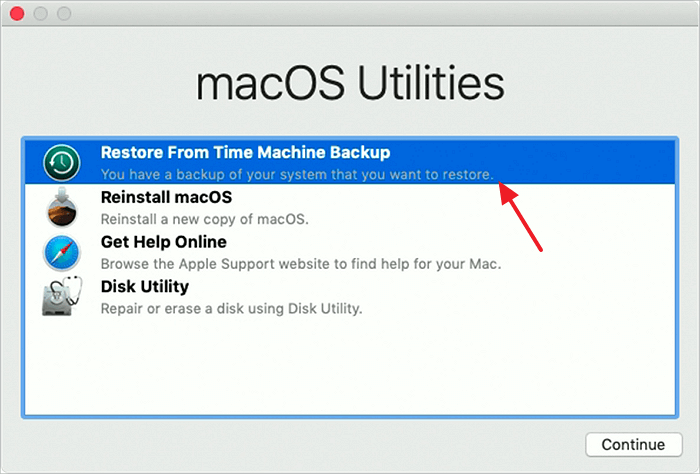
Step 3. Disks connected to your Mac that contain APFS snapshots will be listed. Select the Mac startup disk and click "Continue".
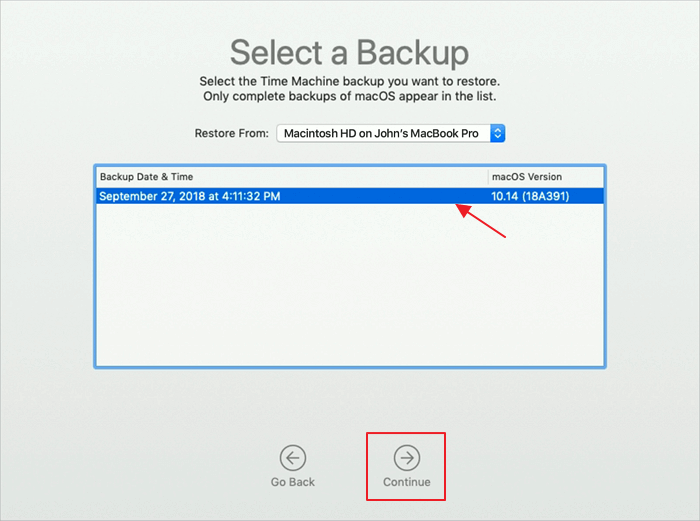
Step 4. A list of snapshots will be displayed sorted by date with the created image of macOS version. Select the snapshot you wish to restore from, then click "Continue".

You will see a process bar, and your Mac will reboot automatically when the recovery is over. After Mac reboots, you can see and access your lost files on your Mac with the previous macOS. If you still want to update to the latest macOS, back up your Mac data and try again.
Conclusion
This page covers 4 practical files to help Mac users to restore missing or lost files due to macOS update. If macOS Catalina or Mojave update deletes everything from your Mac, you can restore lost files from your backup:
Time Machine Backup, iCloud Backup, APFS Snapshot.
If you have no backup, don't worry. You still have a chance by the help of professional data recovery software, like Deep Data Recovery for Mac. It will fully scan and find all your lost Mac files deleted by the macOS update in only three steps.
Related Articles
- Will Formatting My Mac Make It Faster | Here is Answer
- How to Recover Deleted/Disappeared Notes on Mac
- 3 Methods: Recover Unsaved or Lost Excel File on Mac
- Top 5 Completely Free Data Recovery Software for macOS/Mac OS X